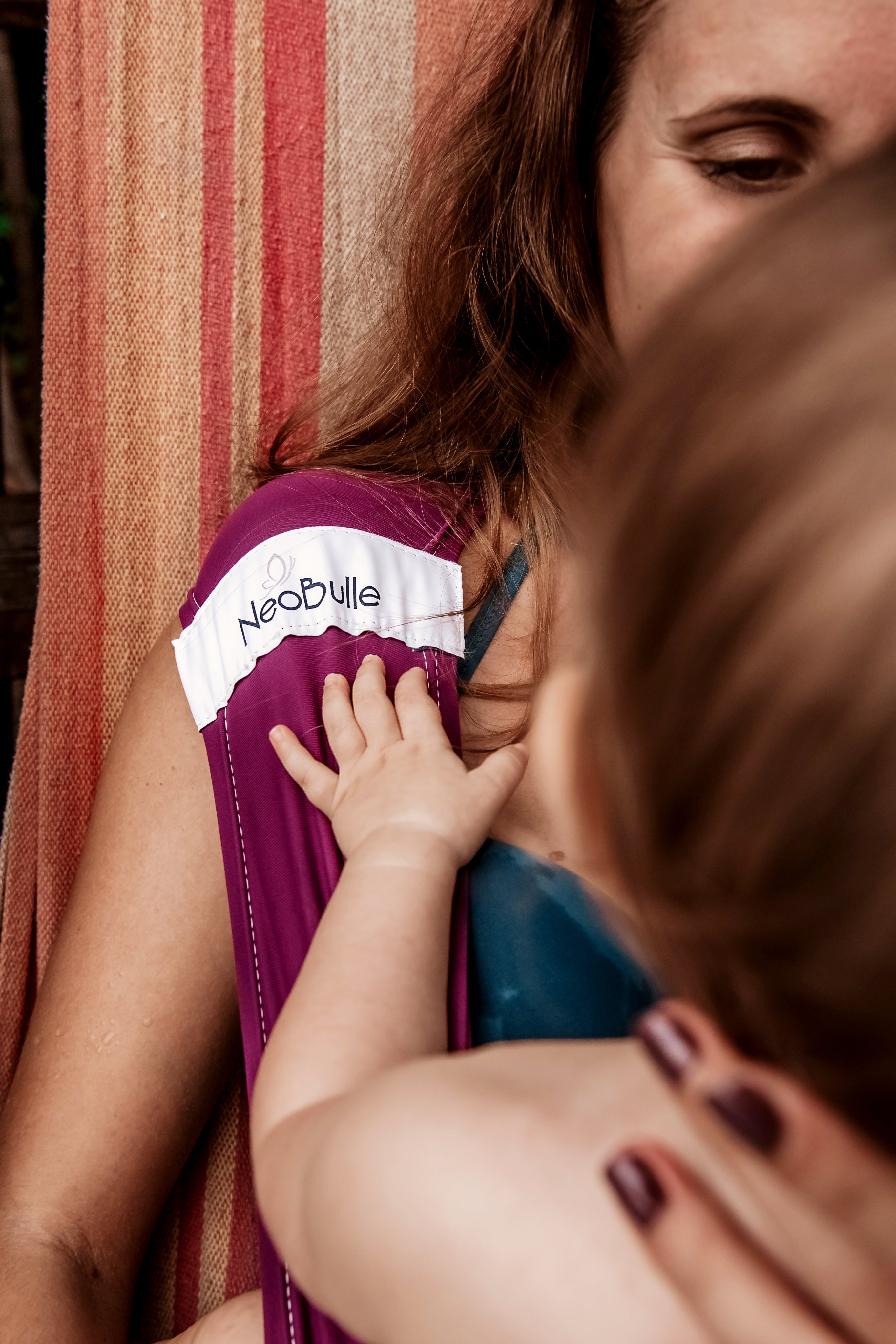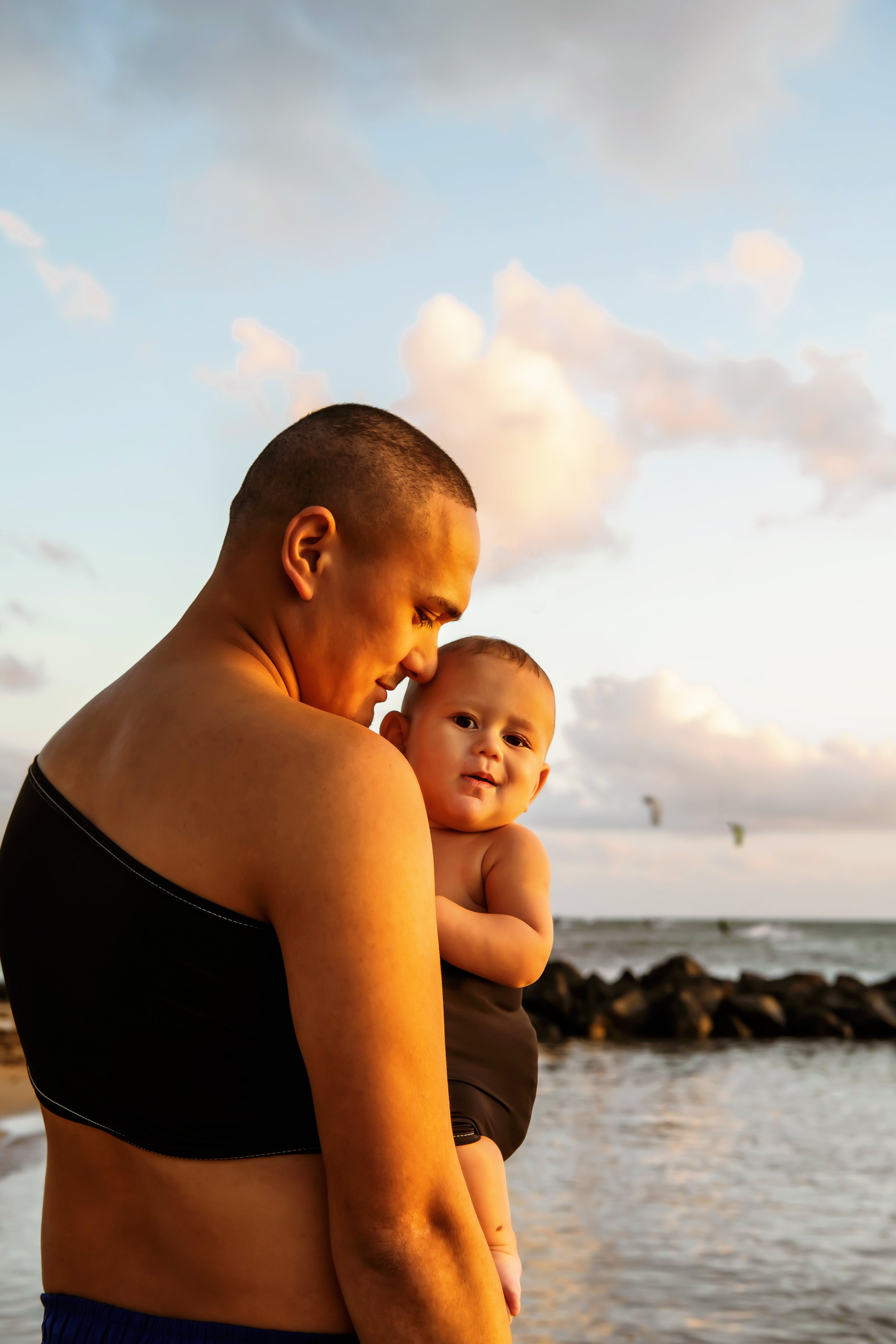You're expecting a baby or have just given birth, and you'd like to try babywearing, but you're not quite sure where to start (with the sling) or how to go about it. And the more links you read on the internet, the more lost you feel! This article is here to help you sort things out and start babywearing calmly.
1 – What is physiological babywearing?
You have probably read this term at least 52 times, but what exactly does it refer to?
We talk about physiological babywearing when it respects the natural posture of the little one.
The main criteria to keep in mind are as follows:
- Rounded lower back: the spine of the newborn is naturally rounded, unlike that of an adult which forms a kind of S, it tends to form a slightly stretched C (like a comma). An upright back position corresponds, in terms of comfort, to an arched position in an adult, which can quickly become uncomfortable
- Knees higher than hips: raising the knees allows the baby to sit well into the hip socket and provides better comfort. To illustrate a posture that does not allow for grouping, you can think of sitting on a tall barstool with legs hanging down.
These two criteria are of course to be considered in a very overall way. When the child grows, for example, their spine will gradually evolve to reach, around 18 months / 2 years, the shape we see in adults. From a newborn often very curled up, you will observe less and less pronounced rounding over the months, especially as the child wakes up and moves around.
Some children are also more tonic than others and will not let you raise their knees higher than their hips, especially common in babies suffering from gastroesophageal reflux (GERD).

This should not become a barrier or a source of stress; your baby does not face any risk of injury or poor development if they are not carried in a perfectly physiological way, the main thing is that they are carried and that it helps you in daily life.
2 – Your first babywearing system: your arms
It is often overlooked, but your first babywearing tool is your arms! Before even considering using any baby carrier, it seems quite logical to start with the basics: being comfortable with handling your little one.
It is recommended to handle your baby respecting their natural wrapping
(see point number 1), we will ensure to limit traction and hyperextension postures. This involves avoiding especially lifting the baby by the armpits, preferring for example to first sit him down and then support him by the hips.Supporting your baby's pelvis provides comfort and stability; its base acts as a center of gravity. This reassures and calms him, and also makes handling him easier for you.
For your comfort, you can prefer using your forearm as support instead of your hand: when carrying with your hand, you tense up enormously, which promotes tension even in the neck and can lead to wrist tendinitis. Moreover, the hand that carries between the baby's legs invites him to lean backward, which is the opposite of the desired effect.
Generally speaking, don't hesitate to use your entire arm and torso to provide a good anchor for your little one without overloading your joints. Remember that when the child reaches 6kg (around 3-4 months), it’s equivalent to carrying a milk pack for several hours a day! Protect your body daily as it is essential from the start. Take the time to find areas on your torso where your baby fits perfectly (body fitting), then adjust the carrier at these points to prevent the head from tilting backward.
3 – Choosing the baby carrier
Choosing your system is often the most difficult step! Wrap, sling, mei-tai, preformed carrier, do these words seem like Chinese to you? Don't panic, that's normal. It is true that the market has developed much faster than the usage instructions, and it’s easy to get lost! We invite you first to read our article on the 10 mistakes to avoid when buying a baby carrier, which can give you some useful tips on the subject.
To simplify things a bit, we suggest you first evaluate your main need: are you considering practical carrying for home, quick errands or school runs, or rather longer duration carrying for baby naps or walks?

The most practical systems are generally slings and preformed carriers
. They settle in very quickly, don't drag on the ground, and allow you to immediately carry the baby.The most durable systems are generally the carrying wraps and the mei-tai. They require a bit more time to set up and adjust properly, but they allow for long-term carrying in the best conditions.
Practicality and comfort unfortunately tend to oppose each other : the more we want a practical system, the fewer adjustments and settings it will have, and the less comfortable it will be (at least it will remain comfortable but less than others). Being comfortable will instead require a bit more manipulation, which doesn't really match ultra-fast setups.
We could compare the wrap to a pair of hiking shoes and the sling to a pair of flip-flops : both are useful but not at the same time ! And just as we wouldn't walk long in flip-flops, we wouldn't wear hiking shoes to go pick up the mail.
Do you want to carry both in daily life and during walks ? Rely on 2 different systems to get the best benefits !
4 – Safety
You have your arms, your baby carrier, your baby, and are well prepared for carrying, bravo ! Now let's talk about safety.
The safety rules for carrying are quite basic :
- Baby vertical and facing you : lying in a system, it risks sinking and the fabric can limit good air circulation, these positions should be reserved exclusively for carrying in the arms. Facing outward is also to be avoided (increased risk of falling).
- Clear airways : your baby's head must always be free, with the carrier and covers pulled up high behind the neck. Is it cold ? Put a hat on! At worst, it's always better to have a small draft than a baby who can't breathe anymore. Clear airways also mean checking that the baby isn't sagging into the fabric: you can pass a finger between their chin and their chest.
- High carry on the chest : a too-low setup will tend to be too loose, and your baby might get squished.
- Well-adjusted baby carrier : the fabric wraps around your little one, the adjustments support them, and they can't slip underneath or fall.
- No sports activities : no running, cycling, skiing, or trampoline with the baby carried!
Other important rules can also be added, even if less essential :
- Flexible clothing that doesn't hinder the baby. Whether in carrying or on the ground, favor loose and non-restrictive clothes; no one would nap or do yoga in slim jeans or a wedding dress, and neither would your baby !
- No coat or snowsuit : it is better to keep your little one as close to you as possible to promote thermoregulation. Thick materials hinder proper adjustments, tend to obstruct the airways, and press on the femoral artery, impairing blood circulation in the legs. Cover him from the outside with a carrying blanket or a coat, for example.
- Regular short breaks so that baby can move a little, ideally every 2-3 hours (which is convenient, as he will generally demand to suck or need his diaper changed around the same rhythm!). In summer, also remember to keep him well hydrated!
Generally, regularly check that everything is OK during carrying.
5 – Choose the right moment
Classic beginner mistake: "Baby is crying! Hmm, what if I put him in the sling I’ve never used in my life?"
Equivalent: "Hey, shall we go take the first driving lesson at Place de l’Étoile in Paris?"
You see, it’s a very bad idea! Even for an experienced carrier, installing a newborn in a remake of The Exorcist in a baby carrier is a delicate exercise. Aim for a moment when everything is OK: baby is calm and fed, you yourself are calm and unconstrained (appointment or other). The first setups are not meant to satisfy a need for carrying but a need to LEARN how to carry.
In practice, it’s quite common for baby to cry during installations; this doesn’t mean he doesn’t like carrying but rather that he doesn’t like the setup in the carrier, which, let’s admit, is not the most pleasant step for him. Don’t hesitate to go all the way as you can (this is not the time to aim for perfect adjustment), walk to calm him down, and then revisit the adjustments afterward.
6 – Enjoy!
That’s it, you’re finally ready! The main thing now is to enjoy these sweet moments with your little heart!
Take your time to learn calmly and without pressure, aiming for reasonable goals at first: a baby who breathes and doesn’t fall. Ease and comfort will come gradually over time. Don’t hesitate to also get support from a carrying instructor!
Happy carrying!





